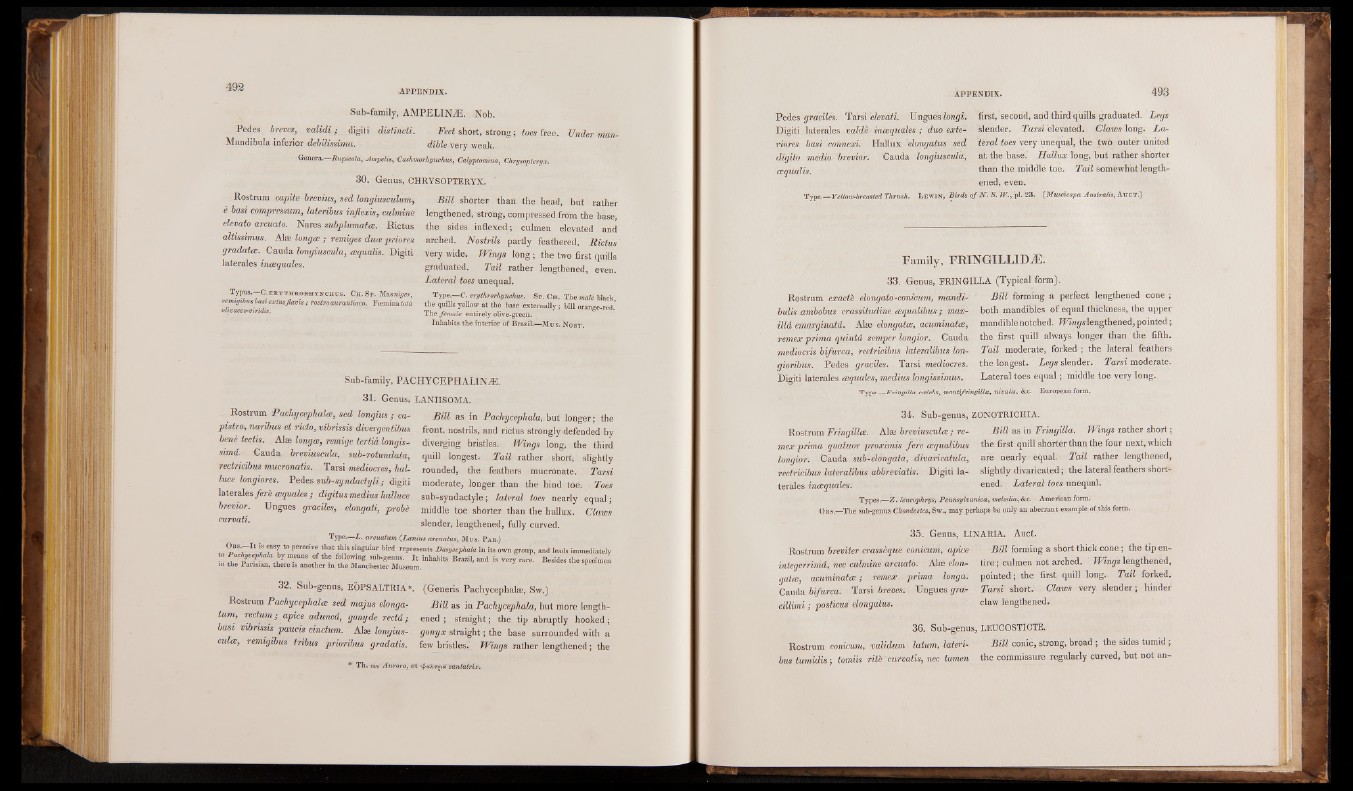
Sub-family, AMPELIN^E. Nob.
Pedes breves, validi;■ digiti distincti. Feet short, strong-; toes free. Under rfian-
Mandibula inferior debilissima. dible very weak.
Genera. Rupicola, Ampelis, Cashmorhynchus, Calyptomind, Chrysopteryx.
30. Genus, CHRYSOPTERYX.
Rostrum capite brevius, sed longiusculum^,
è basi compressum, laieribus inflexis, culminé
elevato arcuato. Nares subplumatce. Rictus
altissimus. Aise longoe ; remiges duce priores
gradatæ. Cauda longiuscula, oequalis. Digiti
latérales incequales.
Typus.—C. ERYTHRefiHYNCHDS. Ch. Sp . Masniger,
remigibus bast extusfiavis ; tostro aurantiaco. Foemina totà
olivaceo-viridis.
Bill shorter than the head, but rather
lengthened, strong, compressed from the base,
the sides inflexed; cnlmen elevated and
arched. Nostrils partly feathered. Rictus
very wide, Wings long; the two first quills
graduated. Tail rather lengthened, even.
Lateral toes unequal.
Type.—C. erythrorhynchm. Sr. Ch . The male black,
the quills yellow at the base externally; hill orange-red*
The female entirely olive-green.
Inhabits the interior of Brazil.—Mu's. Nost.
Sub-family, PACHYCEPHÀLINÆ.
31. Genus* LANIISOMA.
Rostrum Pachycephalce, sed longius ; ca-
pistro, naribus et ricto, vibrissis divérgentibus
bené tectis. Alae longce, remige tertia longis-
simd. • Cauda •, breviuscula, sub-rotundata,
rectricibus mucronatis. Tarsi mediocres, hat-
luce longiores. Pedes sub-syndactyli ; digiti
laterales ferè cequales ; digitus medius halluce
brevior. Ungues graciles, elongati, probè
curvati.
Bill as in Pachycephala, but longer; the
front, nostrils, and rictus strongly defended by
diverging bristles: Wings long* the third
quill longest: Tail rather short) slightly
rounded, the feathers mucronate. . Tarsi
moderate, longer than the hind toé; Toes
sub-syndactyle; lateral toes nearly equal;
middle toe shorter than the hallux. Claws
slender, lengthened, fully curved.
.» '• urouavum {juamus arcuatus, Mbs. Pae.)
OBS—It is easy to perceive that this singular bird represents Dmy'eephala in its own group, and leads immediate!
to Pachycephala by means of the following snb-genns. It inhabits Brazil, and is very r m the Parisian, there is another in the Manchester Museum. . are. Besides the specime.
32. Sub-genus, EÔPSALTRIA*.
Rostrum Pachycephalæ sed magus elongâr
tum, rectum; apice aduncd, gonyde recta;
basi vibrissis paucis cinctum. Alæ longius-
cüloe, remigibus tribus prioribus gradatis.
(Generis Pachycephalae, Sw.)....
Bill as in Pachycephala, but more lengthened
; straight; the tip abruptly hooked ;
gonyx straight; the base surrounded with a
few bristles. Wings rather lengthened; the
Th. tui Aurora, et iJ/eixr^ia ccmtatrix.
Pedes graciles. Tarsi elevati. Ungues longi.
Digiti laterales valde incequales ; duo exte-
riores basi cohnexi. Hallux elongatus sed
digito medio brevior. Cauda longiuscula,
cequalis.
Type.—Yellow-breasted Thrush. Dewin, Birds
first, second, and third quills graduated. Legs
slender. Tarsi elevated. Claws long. Lateral
toes very unequal, the two outer united
at the base. Hallux long, but rather shorter
than the middle toe. Tail somewhat lengthened,
even.
' N . S. W., pi. 23. (Muscicapa Australis, Aucx.)
Family, FRINGILLIDÆ.
33. Genus, FRINGILLA (Typical form).
Rostrum exacts elongato-conicum, mandi-
bulis ambobus crassitudine cequalibus ; maxilla
emarginatd. Alae elongates, acuminates,
remex prima quinta semper longior. Cauda
medioens bifurca, rectricibus lateralibus lon-
gioribus. Pedes graciles. Tarsi mediocres.
Digiti laterales cequales, medius longissimus.
Bill forming a perfect lengthened cone ;
both mandibles of equal thickness, the upper
mandible notched. Wings lengthened, pointed;
the first quill always longer than the fifth.
Tail moderate, forked; the lateral feathers
the longest. Legs slender. Tarsi moderate.
Lateral toes equal; middle toe very long.
Type._Fringilla ccelebs, montifringilla, nivalis, &c. European form.
34. Sub-genus,
Rostrum Fringillce. Alæ breviusculoe ; remex
prima quatuor proximis fere cequalibus
longior. Cauda sub-elongata, divaricatula,
rectricibus lateralibus abbreviatis. Digiti laterales
incequales.
ZONOTRICHIA.
Bill as in Fringilla. Wings rather short;
the first quill shorter than the four next, which
are nearly equal! Tail rather lengthened,
slightly divaricated; the lateral feathers shortened!
Lateral toes unequal.
American form;
Types.—Z. leucophrys, Pennsylvanica, melodia, &c.
only an aberrant example of this form.
Obs.—The sixb-genus Chondestes, Sw., may perhaps be
35. Genus. LIN ARIA. Auct.
Rostrum breviter crasseque conicum, apice
integerrima, nec culmihe arcuato. Alae elon-
gates, acuminata:; remex prima longa:
Cauda bifurca: Tarsi breves: Ungues grdcillimi;
posticus elongatus.
Bill forming a short thick cone; the tip entire;
culmen hot arched. Wings lengthened,
pointed; the first quill long. Tail forked.
Tarsi short. Claws very slender; hinder
claw lengthened.
36. Sub-genus, LEUCOSTICTE.
Rostrum conicum, validum latum, lateri- Bill conic, strong, broad ; the sides tumid;
bus tumidis; tomiis rité curvatis, nec tamen the commissure regularly curved, but not an